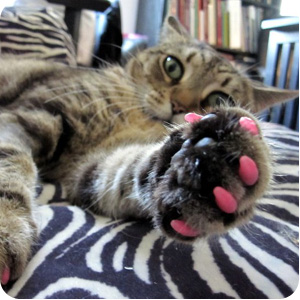Scratching Problems
 Scratching is a natural behavior and a reality of sharing your home with a cat. While you can provide scratching posts and other outlets for your cat’s scratching needs, you will never be able to completely eliminate scratching of furniture, rugs, and other items. If you buy a $2,500 leather couch, don’t blame your cat when it gets ruined! If you want to learn about declawing, please read this excellent article on declawing written by a veterinarian. If you’re looking for information on aggressive behavior, visit our Aggression page. Otherwise, continue reading below to find out how you can encourage your kitty to scratch a designated item, not your favorite couch.
Scratching is a natural behavior and a reality of sharing your home with a cat. While you can provide scratching posts and other outlets for your cat’s scratching needs, you will never be able to completely eliminate scratching of furniture, rugs, and other items. If you buy a $2,500 leather couch, don’t blame your cat when it gets ruined! If you want to learn about declawing, please read this excellent article on declawing written by a veterinarian. If you’re looking for information on aggressive behavior, visit our Aggression page. Otherwise, continue reading below to find out how you can encourage your kitty to scratch a designated item, not your favorite couch.
Scratching posts
If you don’t give your cats a designated spot to scratch, they will ruin your furniture! Most of the cats we know like sisal rope and cardboard scratchers better than carpet-covered posts. The wedge-shaped cardboard scratchers are a hit in most households. The corrugated replacement inserts keep them fresh, and many of them even come with catnip to entice your cat to scratch. You can also make your own scratching post with some cheap wood posts or boards covered in sisal rope. A sheet of corrugated cardboard works well, too. As with litterboxes, you should provide an appropriate number of scratching posts (at least one per cat) and spread them out across your home. That way if your cat gets an urge to scratch in any area of your home, he/she won’t have to go far.
Clipping nails
Trimming your cat’s claws won’t prevent scratching, but it will reduce damage to your furniture and rugs. It will also keep your cat from getting her paw stuck to a window screen or your couch (how embarrassing!). To learn how, type “how to clip a cat’s nails” into your favorite search engine — there are lots of videos and instructional articles available on the web. Your vet office staff may also be able to show you how.
Nail covers
SoftPaws are a wonderful tool for pet owners who just can’t prevent their cat from scratching furniture (or people, for that matter). You clip the tip of your cat’s nails, apply the nail covers with a mild glue, and replace every 4-6 weeks. Check out Sadie in the photo at the top of this page, who is modeling her pink SoftPaws.
Encouragement with catnip
Not all cats respond to catnip, and cats under 9 months aren’t likely to enjoy it, but many adults can’t get enough of the stuff! When you introduce your new scratching devices, sprinkle them with catnip. Make it fun and satisfying for your cat to scratch.
About punishment
Do not directly punish your cat for scratching — she won’t understand or respond. Try placing the scratching posts in front of the object she is scratching, or cover the object with tinfoil or double-sided tape to discourage her. You can also try squirting her with water, clapping your hands, or shaking an empty soda can full of coins when you see her scratching something that is off-limits. Alternately, you can pick her up and place her on the scratching post, then praise her when she uses it. Some people also have luck with citrus sprays and other scents which cats may find unpleasant.
Web Resources
Cornell University School of Veterinary Medicine offers an excellent free video series, Managing Scratching Behavior. We highly recommend it.









